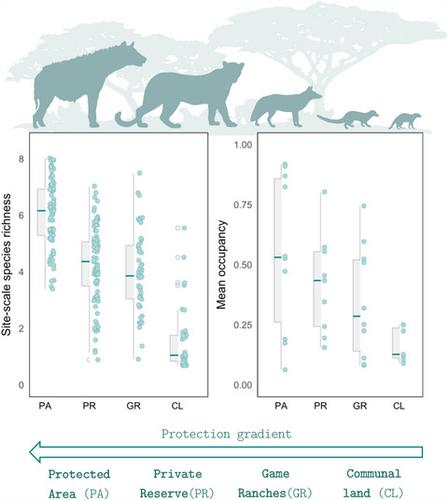当前位置:
X-MOL 学术
›
J. Appl. Ecol.
›
论文详情
Our official English website, www.x-mol.net, welcomes your feedback! (Note: you will need to create a separate account there.)
Responses of carnivore assemblages to decentralized conservation approaches in a South African landscape
Journal of Applied Ecology ( IF 5.7 ) Pub Date : 2020-08-25 , DOI: 10.1111/1365-2664.13726 Gonçalo Curveira‐Santos 1 , Chris Sutherland 2 , Margarida Santos‐Reis 1 , Lourens H. Swanepoel 3, 4
中文翻译:

南非景观中食肉动物组合对分散式保护方法的反应
更新日期:2020-08-25
Journal of Applied Ecology ( IF 5.7 ) Pub Date : 2020-08-25 , DOI: 10.1111/1365-2664.13726 Gonçalo Curveira‐Santos 1 , Chris Sutherland 2 , Margarida Santos‐Reis 1 , Lourens H. Swanepoel 3, 4
Affiliation

|
- Conservation efforts in South Africa play out across multi‐use landscapes where formal protected areas coexist with private wildlife business (ecotourism and/or hunting) in a human‐dominated matrix. Despite the persistence of highly diverse carnivore guilds, management idiosyncrasies are often orientated towards charismatic large predators and assemblage‐level patterns remain largely unexplored.
- We conducted an extensive camera‐trap survey in a natural quasi‐experimental setting in KwaZulu‐Natal, South Africa. We sampled across a protection gradient characterized by a provincial protected area (highest and formal protection status), a private ecotourism reserve, game ranches and traditional communal areas (lowest protected status). We evaluated assemblage‐level and species‐specific responses of free‐ranging carnivores to the varying management contexts and associated environmental gradients.
- Despite similar assemblage composition between management contexts, site‐scale carnivore richness and occupancy rates were greater in the formal protected area than adjacent private reserve and game ranches. Carnivore occupancy was more similar between these private wildlife areas, although putative problem species were more common in the private reserve, and contrasted with depauperate assemblages in least protected communal lands. Variation in carnivore occupancy probabilities was largely driven by land use contexts, that is, the level and nature of protection, relative to underlying fine‐scale landscape attributes (e.g. distance to conservation fences) or apex predator populations.
- Synthesis and applications. Our findings provide convincing empirical support for the added value of multi‐tenure conservation estates augmenting and connecting South Africa's protected areas. However, our emphasis on free‐ranging carnivores exemplifies the importance of maintaining areas under long‐term formal protection and the risks with viewing lucrative wildlife business as a conservation panacea. We suggest that unmanaged carnivore species be the formal components of carnivore reintroduction and recovery programmes to better gauge the complementary conservation role of South Africa's private land.
中文翻译:

南非景观中食肉动物组合对分散式保护方法的反应
- 南非的保护工作遍及多种用途的景观,在这些景观中,正式的保护区与私人野生动植物商业(生态旅游和/或狩猎)共存,以人为主导。尽管高度多样化的食肉动物行会持续存在,但管理特质通常面向具有魅力的大型捕食者,并且在很大程度上没有探索组合级别的模式。
- 我们在南非夸祖鲁-纳塔尔省的自然准实验环境中进行了广泛的相机陷阱调查。我们在保护梯度上取样,该梯度的特征是省级保护区(最高和正式保护状态),私人生态旅游保护区,狩猎场和传统公共区(最低保护状态)。我们评估了自由放养的食肉动物对不同管理环境和相关环境梯度的组合水平和物种特异性反应。
- 尽管管理环境之间的组合组成相似,但正式保护区中站点规模的食肉动物丰富度和占用率要高于相邻的私人保护区和狩猎场。在这些私人野生动植物地区之间,食肉动物的占有更为相似,尽管在私人保护区中假定的问题物种更为常见,并且与保护程度最低的公共土地上的退化种群形成对比。食肉动物的居住概率的变化在很大程度上是由土地使用环境决定的,即相对于潜在的精细尺度景观属性(例如,到保护栅栏的距离)或天敌食肉动物种群的保护水平和保护性质。
- 综合与应用。我们的发现为扩大和连接南非保护区的多期保护区的附加值提供了令人信服的经验支持。但是,我们对自由放养的食肉动物的重视体现了将地区维持在长期正式保护之下的重要性,以及将利润丰厚的野生动植物企业视为保护灵丹妙药的风险。我们建议将未经管理的食肉动物物种作为食肉动物重新引入和恢复计划的正式组成部分,以更好地评估南非私有土地的互补保护作用。


























 京公网安备 11010802027423号
京公网安备 11010802027423号